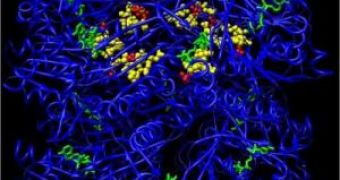Every living thing, from bacteria to humans, functions on a 24 hours pattern.
This is dictated by microscopic pacemakers, biochemical clocks.
A traveler experiences jet lag when his/her internal clock does not match the local time.
Impairments in the biological clock have been linked to Seasonal Affective Disorder, some types of depression, sleep disorders, changes in work cycles and even cancer.
In 2005, a Japanese team made a breakthrough when they found world's first biochemical clock, made of three proteins, in blue green algae (a type of photosynthetic bacteria).
The proteins, labeled KaiA, KaiB and KaiC, established a 24-hour cycle on their own when located in a test tube with adenosine triphosphate (ATP), the compound that powers biological reactions.
Now, an interdisciplinary team at Vanderbilt University has investigated how the sole known biological clock works. "We all thought the system was much more complicated and required feedback from the cell's genetic machinery in order to work," said Carl Johnson, professor of biological sciences and lead researcher.
The basic question was how these molecules, which are undergoing reactions at a second-by-second and minute-by-minute frequency, can sustain a 24-hour cycle. KaiC is the largest of these proteins, a barrel-shaped molecule made of six identical monomers.
The diurnal cycle appeared correlated to regular increase and decrease in the number of phosphate groups attached to the KaiC molecules. The attachment and detachment of phosphate groups (phosphorylation and dephosphorylation) is a common way to activate or inhibit a protein, permitting the bioclock to turn on or off various cellular processes.
The team knew that when KaiA binds to KaiC the phosphorylation rate increases, either by making it easier for phosphate groups to bind to the KaiC or making it more difficult for them to leave. On the contrary, KaiB doesn't bind to KaiC until it is highly phosphorylated and when it does, KaiB counteracts the influence of KaiA.
The team imagined a relatively simple process: KaiA binds with KaiC and phosphorylation would gradually rise for 12 hours. Then something activates KaiB to begin bonding with these complexes and the phosphorylation would gradually drop for 12 hours.
But the transmission electron microscope revealed that KaiB and KaiC "complexes do not form one static structure," said Associate Professor Phoebe Stewart, an expert on electron microscopy. "It doesn't go from complex one to complex two three hours later and then three hours later to the next complex. Instead, you have mixtures of all different complexes at all time points, just in different ratios."
The team assigned the 24-hour cycle to seven equal phases: starting at the lowest level of KaiC phosphorylation, in phases Up1 and Up2 the phosphorylation level increases until it reaches a peak level.
Following this "P" phase, the KaiC begins dephosphorylating through phases Down1, Down2 and Down3, reaching its lowest level in the "T" phase (T for trough) and then it starts over.
Besides KaiA, KaiB and KaiC, the test tube also contained large levels of a smaller molecule, called monomer, the basic building block for the Kai proteins. KaiC is a hexamer that is made up of six monomers, KaiA of two (dimer) and KaiB of four (tetramer).
The monomers were found to continuously combine into complexe Kai proteins and break up again.
The team realized a model in which the system's stability is given by the exchange of monomers by KaiC hexamers. "The 24-hour cycle is the variation in the average phosphorylation level of the hexamers. To produce sustained rhythms in the system, you must have some way to synchronize the phosphorylation levels of individual hexamers," said biomathematician Mark Byrne, a research fellow in pharmacology.
Because KaiC proteins are exchanging monomers at a substantially faster rate than the process of phosphorylation and dephosphorylation keeps phosphorylation levels evenly distributed throughout the KaiC population. "If the population becomes asynchronous -- that is, if some hexamers phosphorylate and dephosphorylate out of synch with the others -- then the hexamers will start oscillating out of phase with each other and you will lose the rhythm."
The model solves the mystery of why a specific proportion of the three proteins is required to establish the 24-hour rhythm, how temperature can reset the system and the general traits of the bioclock system. "This paper is our first step toward visualizing what is happening during the 24-hour cycle. The next level of understanding will be how the proteins work together as a nanomachine to carry out their job", said Stewart.
Of course, how bioclock systems work in living cells is substantially more complex than what occurs in a test tube. There are also additional levels of regulation, like control of the synthesis of the bioclock monomers.

 14 DAY TRIAL //
14 DAY TRIAL //